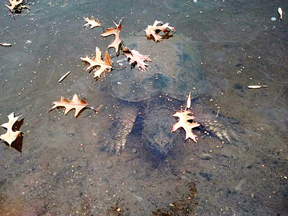Where Did Everybody Go?
By Thomas Waser In Cold Blooded CreaturesIt’s getting pretty cold out there, and as you’ve seen birds migrating south for the winter and local mammals bedding down for hibernation, you may have noticed that the native reptiles and amphibians have vanished as well. No more frogs and toads calling in the evenings, no turtles basking on logs in the local ponds, and even the little skinks skittering for food between the rocks have disappeared. So where did everybody go? What do reptiles and amphibians do all winter long?
Short answer: They hibernate! Like mammals, reptiles and amphibians hunker down for the winter, decreasing their body temperature, heart rate, and rate of digestion. Also like mammals, the fat they have been storing all summer long will keep them nourished through the long winter.
Turtles will retreat to the muddy bottom of local ponds and lakes, where their body temperature will be the same as the temperature of the surrounding water (generally around 40 degrees F). But they are not completely dormant; recent studies have shown that, while slowed down, turtles are still active during the winter, and can even be observed swimming below the ice. These animals can absorb oxygen through their skin so they don’t need to surface. The Eastern Painted Turtle can actually survive long periods without oxygen, and may go without taking a breath for up to five months!


A snapping turtle lumbering beneath the ice. Wisconsin DNR Photo.
Snakes will make use of burrows or rocky crevices to protect them from the cold. While they may hide away in solitude, many species will hibernate together in a big knot, where their close proximity will keep each other from completely freezing. These group hibernation sites are called a hibernaculum, and these hibernaculum sites may house multiple species, including venomous and non-venomous snakes together. In extreme cases, scientists have found as many as one hundred snakes sharing the same cave during the winter season! When spring arrives, the snakes emerge to bask and warm themselves in the sun.


Two Dekay’s Snakes huddle together to protect themselves from the cold.
Aquatic frogs and salamanders will also hibernate in the muddy bottom of ponds. Here they will absorb oxygen through their skin from the mud that surrounds them, rather than using their lungs. Terrestrial frogs, toads and salamanders will lie dormant under leaf litter and logs, and will keep themselves warm under the blanket of snow. Some frogs have taken their hibernation practice to the extreme; the Wood Frog, native to Virginia but found as far north as Alaska, is known for its incredible ability to freeze the majority of its body, even stopping its heart from beating! Natural antifreeze keeps ice from forming inside the frog’s cells, and when the weather warms up, the wood frog thaws out and beings looking for food and a mate.


Though it may appear dead, this Wood Frog will reawaken in the spring. Photo by Janet Storey.
Though they may be out of our sight, our reptile and amphibian friends are still here, buried beneath our feet or submerged in the local ponds. Though cold blooded, these creatures are well adapted to our harsh winters, and you can bet that you will see them again early next spring!






No Comment
Sorry, the comment form is closed at this time.